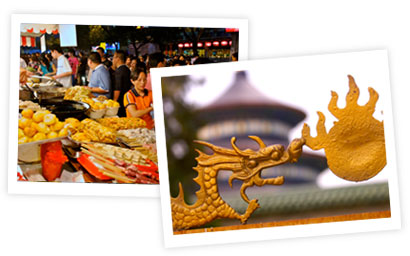 |
|
|
 UK: 0845 521 2910 UK: 0845 521 2910 | |
 USA: 1 8665 224308 USA: 1 8665 224308 | |
 AUS: 1300 654 861 AUS: 1300 654 861 | |
 expert@trans-siberian.co.uk expert@trans-siberian.co.uk | |

Destinations
Email an expert
All of our trips have a pre-arranged schedule. However if you would like to customise your journey, please let us know how by either calling us on 0845 521 2910 or emailing us
Beijing
Beijing was not always the Chinese capital – different ruling dynasties have usually moved the role of capital to their home city within the country, and Beijing was no exception to this. Beijing’s founders had come from Mongolia, and the city was originally named Khanbaliq in Mongolian. But it in turn had been built on the site of the city destroyed by the Mongolian invaders, and this in turn gave way to subsequent reinventions of the city under a more typically Chinese culture. However, as it was the custom of each new dynasty to remove the power-structure of its predecessor, the previous capitals of China – with the exception of Xi’an, built on such a scale it was hard to eradicate – were mostly deliberately downgraded and had their palaces and royal structures removed to prevent them becoming powerful once again. Thus Beijing, as the most recent of the Imperial capitals of China, retains the greatest number of Imperial buildings… although even these have been reduced by the change to Communism, and the 1960s policy of “cultural revolution” that aimed to destroy the previoue Imperial culture.

What to see in and around Beijing
The Forbidden City
The Forbidden City was a city-within-a-city, to which access was “forbidden” to all but the select grouping of administrators and burocrats who administered the Empire on behalf of their royal masters. A further unusual factor was that – in order to prevent these administrators favouring their own families or children with valuable official appointments – virtually the entire structure of administration was formed from castrated male eunuchs, who had no children to care for. The Forbidden City is an enormous walled city that really needs at least a full half-day to see even the majority of palaces, temples, museums and exhibitions within its huge scope.
The Temple Of Heaven
The Temple Of Heaven was the Daoist temple at which the Emperors would make offerings for a plentiful harvest for the country - no paradox was felt in attending both Buddhist and Daoist ceremonies.
The Summer Palace...
... was a beautiful series of gardens, lakes and summer lodges where the royal family could spend the warm summer days in relaxed comfort and elegance. It remains one of the most pleasant spots in which to pass an afternoon in Beijing, and is one of own special favourites whenever we visit Beijing.
The Great Wall
The Great Wall can be visited at several different spots. Contrary to popular myth, it is not complete and there are missing sections even close to Beijing – you cannot just walk on it wherever you want (although there are also long intact sections too). There was also not just one single Great Wall – the project was begun several times in different epochs, when different areas of the country needed protection.
The Lama Temple
The Lama Temple was the most prestigious of the Buddhist Temples in Beijing – effectively the Legation of the Dalai Lama, who remained in Lhasa as the nation’s spiritual leader. The differences between the modern Chinese State and Buddhism have been played-out here – the exhibition of “famous scenes in Buddhist history” contains some rather notorious fakes. Nevertheless the Temple remains an important Buddhist site, and should not be “left off” your visit simply because of what the Chinese Govt choose to say about it.
The Silk Market...
... although it’s a bit of a cliché, it still has nice silk stuff that makes an unusual gift from your trip.
The Antiques Market..
... probably this ought to be called The Fake Antiques Market, but the fakes are very attractive… frankly if that Buddha statue really was from the C15th you wouldn’t be paying £10 for it anyhow. The market also has a huge number of nice handicraft souvenirs and gifts that you can actually use (tablecloths, bedlinen sets etc) rather than mantelpiece dust-gatherers.
The Ming Tombs
This excursion is rather hokum – the tombs were robbed centuries ago, and there is nothing to see – but the trip down into them is a pleasantly cool relief from the summer heat, and there’s a nice lunch included too. Rather more attractive are the statues of fantastical beasts which once belonged to the Emperors.











